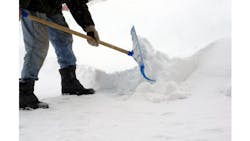Off-the-Job Safety: Getting a Handle on Proper Snow-Shoveling Techniques
A national study in the American Journal of Emergency Medicine estimates that U.S. hospitals treat 11,500 snow-shoveling-related injuries and medical emergencies every year. Here’s the bottom line: Although shoveling snow can be good exercise, it also can be dangerous for optimistic shovelers who take on more than they can handle.
“Contrary to what many people believe, snow shoveling is no different than any other type of vigorous physical activity,” said Lisa Hoglund, Ph.D., a physical-therapy professor at the University of the Sciences in Philadelphia. “That’s why it’s important for people to ease into the workout, practice proper technique and rest when needed.”
Hoglund offers these tips for preventing injuries:
- Warm up. Before heading outdoors, take 10 minutes to jog in place or run up stairs, and stretch to get your muscles warmed up.
- Use an ergonomic shovel. Ergonomically correct shovels are typically much lighter than normal shovels and have a contoured handle designed to reduce or eliminate bending and decrease lifting.
- Proper technique is key. Stand with your feet about hip width for balance, and keep the shovel close to your body. Be sure to push the snow instead of lifting it. If you have to lift, bend your knees and lift with your legs, and avoid twisting or throwing snow over your shoulder.
- Take light loads. Because each large shovelful of snow can weigh up to 30 pounds, smaller loads are recommended to help prevent injuries.
- Listen to your body. Take breaks every 15 minutes, and be sure to pay attention to your body's signals, such as pains, shortness of breath, or chest discomfort.
“Snow removal is more than just another necessary household chore, because all the bending and heavy lifting can put an individual at serious risk for injury and even a heart attack,” Hoglund said.
